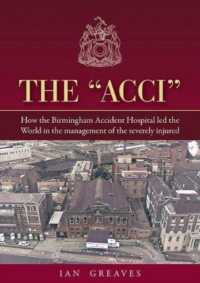- ホーム
- > 洋書
- > 英文書
- > Politics / International Relations
基本説明
This book offers a detailed study of how regulation works in practice, its legal framework, and the arguments surrounding its economic and social impact.
Full Description
Tony Prosser examines a range of different British regulatory bodies, including the Human Fertilisation and Embryology Authority, the Food Standards Agency, the Environment Agency, the Health and Safety Executive, the regulators for health and social care, and the utility regulators covering communications, energy, rail, and water. He emphasizes that no regulator works in isolation but is part of a complex network of different institutions, including central government departments and European institutions. Effective regulatory accountability requires that the relations between the different bodies are clear and transparent, and the book assesses the extent to which this is achieved in practice.
Prosser also highlights the range of tasks which regulators perform. Many regulators are responsible for economic regulation aimed at increasing efficiency and promoting consumer choice, but they also have other roles, notably protecting human rights, promoting social solidarity and social inclusion, and providing a forum for deliberation and learning through listening to different interests. The different legal duties of regulators, and their operation in practice, are examined in relation to each of these roles, with an emphasis on how regulators ought to decide and how they can be held accountable for their decisions.
Finally, the book looks at how regulators themselves are regulated as part of the 'better regulation' initiative, it examines attempts to reduce regulatory burdens and to improve regulatory procedures, for example through the use of regulatory impact analysis. It also features comparative analysis of experience from France and the USA.
Contents
1. Introduction: Two Visions of Regulation and Four Regulatory Models ; 2. The Human Fertilisation and Embryology Authority ; 3. The Food Standards Agency ; 4. The Environment Agency ; 5. The Health and Safety Executive ; 6. The Care Quality Commission and its Predecessors ; 7. Monitor, the Independent Regulator of NHS Foundation Trusts ; 8. The Office of Communications ; 9. The Utility Regulators: The Office of Gas and Electricity Markets, the Water Services Regulation Authority, and the Office of Rail Regulation ; 10. Regulating the Regulators ; 11. Comparisons and Conclusions







